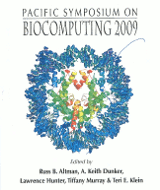A Multiscale Approach to Sampling Nascent Peptide Chains in the Ribosomal Exit Tunnel
V. A. Voelz, P. Petrone, and V. S. Pande
Department of Chemistry, Stanford University, Stanford, CA 94305, USA
Email: pande@stanford.edu
Pacific Symposium on Biocomputing 14:340-352(2009)

Abstract
We present a new multiscale method that combines all-atom molecular dynamics with coarse-grained sampling, towards the aim of bridging two levels of physiology: the atomic scale of protein side chains and small molecules, and the huge scale of macromolecular complexes like the ribosome. Our approach uses all-atom simulations of peptide (or other ligand) fragments to calculate local 3D spatial potentials of mean force (PMF). The individual fragment PMFs are then used as a potential for a coarse-grained chain representation of the entire molecule. Conformational space and sequence space are sampled efficiently using generalized ensemble Monte Carlo. Here, we apply this method to the study of nascent polypeptides inside the cavity of the ribosome exit tunnel. We show how the method can be used to explore the accessible conformational and sequence space of nascent polypeptide chains near the ribosome peptidyl transfer center (PTC), with the eventual aim of understanding the basis of specificity for co-translational regulation. The method has many potential applications to predicting binding specificity and design, and is sufficiently general to allow even greater separation of scales in future work.
Keywords: multi-scale modeling, molecular dynamics, ribosome exit tunnel, generalized ensemble, translation, PMF, coarse-grain, Monte Carlo.
[Full-Text PDF] [PSB Home Page]